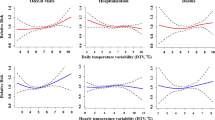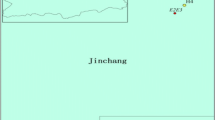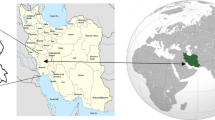Abstract
Purpose
Diurnal temperature range (DTR) is a meteorological indicator closely associated with global climate change. Thus, we aim to explore the effects of DTR on the outpatient and emergency room (O&ER) admissions for cardiovascular diseases (CVDs), and related predictive research.
Methods
The O&ER admissions data for CVDs from three general hospitals in Jinchang of Gansu Province were collected from 2013 to 2016. A generalized additive model (GAM) with Poisson regression was employed to analyze the effect of DTR on the O&ER admissions for all cardiovascular diseases, hypertension, ischemic heart disease (IHD) and stoke. GAM was also used to preform predictive research of the effect of DTR on the O&ER admissions for CVDs.
Results
There were similar positive linear relationships between DTR and the O&ER visits with the four cardiovascular diseases. And the cumulative lag effects were higher than the single lag effects. A 1 °C increase in DTR corresponded to a 1.30% (0.99–1.62%) increase in O&ER admissions for all cardiovascular diseases. Males and elderly were more sensitivity to DTR. The estimates in non-heating season were higher than in heating season. The trial prediction accuracy rate of CVDs based on DTR was between 59.32 and 74.40%.
Conclusions
DTR has significantly positive association with O&ER admissions for CVDs, which can be used as a prediction index of the admissions of O&ER with CVDs.



Similar content being viewed by others
Availability of data and materials
Not applicable.
References
Braganza K, Karoly DJ, Arblaster JM (2004) Diurnal temperature range as an index of global climate change during the twentieth century. Geophys Res Lett 31(13):L13217
Cao J, Cheng Y, Zhao N et al (2009) Diurnal temperature range is a risk factor for coronary heart disease death. J Epidemiol 19(6):328–332
Chen G, Zhang Y, Song G et al (2007) Is diurnal temperature range a risk factor for acute stroke death? Int J Cardiol 116(3):408–409
Cheng J, Xu Z, Zhu R et al (2014) Impact of diurnal temperature range on human health: a systematic review. Int J Biometeorol 58(9):2011–2024
Cheong YL, Burkart K, Leitão PJ et al (2013) Assessing weather effects on dengue disease in Malaysia. Int J Environ Res Public Health 10(12):6319–6334
Colón-González FJ, Fezzi C, Lake IR et al (2013) The effects of weather and climate change on dengue. PLoS Negl Trop Dis 7(11):e2503
Ding Z, Li L, Xin L et al (2016) High diurnal temperature range and mortality: Effect modification by individual characteristics and mortality causes in a case-only analysis. Sci Total Environ 544:627–634
Guo Y, Barnett A, Yu W et al (2011) A large change in temperature between neighbouring days increases the risk of mortality. PLoS ONE 6(2):e16511
Guo Y, Li S, Liu DL et al (2016) Projecting future temperature-related mortality in three largest Australian cities. Environ Pollut 208:66–73
Hansen J, Sato M, Ruedy R (1995) Long-term changes of the diurnal temperature cycle: implications about mechanisms of global climate change. Atmos Res 37(1–3):175–209
Hastie T, Tibshirani R (1995) Generalized additive models for medical research. Stat Methods Med Res 4(3):187–196
Honda Y, Kondo M, McGregor G et al (2014) Heat-related mortality risk model for climate change impact projection. Environ Health Prev Med 19(1):56–63
Huang J, Zeng Q, Pan X et al (2019) Projections of the effects of global warming on the disease burden of ischemic heart disease in the elderly in Tianjin, China. BMC Public Health 19(1):1465
Jain R, Sontisirikit S, Iamsirithaworn S et al (2019) Prediction of dengue outbreaks based on disease surveillance, meteorological and socio-economic data. BMC Infect Dis 19(1):272
Kan H, London SJ, Chen H et al (2007) Diurnal temperature range and daily mortality in Shanghai, China. Environ Res 103(3):424–431
Kawahara J, Sano H, Fukuzaki H et al (1989) Acute effects of exposure to cold on blood pressure, platelet function and sympathetic nervous activity in humans. Am J Hypertens 2(9):724–726
Keatinge WR, Coleshaw SR, Easton JC et al (1986) Increased platelet and red cell counts, blood viscosity, and plasma cholesterol levels during heat stress, and mortality from coronary and cerebral thrombosis. Am J Med 81(5):795–800
Kovats RS, Kristie LE (2006) Heatwaves and public health in Europe. Eur J Public Health 16(6):592–599
Lee JY, Kim H, Gasparrini A et al (2019) Predicted temperature-increase-induced global health burden and its regional variability. Environ Int 131:105027
Li T, Horton RM, Bader DA et al (2016) Aging will amplify the heat-related mortality risk under a changing climate: projection for the elderly in Beijing, China. Sci Rep 6(1):28161
Li G, Li Y, Tian L, Guo Q, Pan X (2018) Future temperature-related years of life lost projections for cardiovascular disease in Tianjin, China. Sci Total Environ 630:943–950
Lian H, Ruan Y, Liang R et al (2015) Short-term effect of ambient temperature and the risk of stroke: a systematic review and meta-analysis. Int J Environ Res Public Health 12(8):9068–9088
Lim Y, Hong Y, Kim H (2012a) Effects of diurnal temperature range on cardiovascular and respiratory hospital admissions in Korea. Sci Total Environ 417–418:55–60
Lim Y, Park A, Kim H (2012b) Modifiers of diurnal temperature range and mortality association in six Korean cities. Int J Biometeorol 56(1):33–42
Lim YH, Reid CE, Mann JK et al (2015) Diurnal temperature range and short-term mortality in large US communities. Int J Biometeorol 59(9):1311–1319
Lin X, Liao Y, Hao Y (2018) The burden associated with ambient PM2.5 and meteorological factors in Guangzhou, China, 2012–2016: a generalized additive modeling of temporal years of life lost. Chemosphere 212:705–714
Liu FD, Shen XL, Zhao R et al (2016) Pulse pressure as an independent predictor of stroke: a systematic review and a meta-analysis. Clin Res Cardiol 105(8):677–686
Liu H, Tian Y, Xu Y et al (2017) Association between ambient air pollution and hospitalization for ischemic and hemorrhagic stroke in China: a multicity case-crossover study. Environ Pollut 230:234–241
Lock K (2000) Health impact assessment. BMJ 320(7246):1395–1398
Ma W, Sun X, Song Y et al (2013) Applied mixed generalized additive model to assess the effect of temperature on the incidence of bacillary dysentery and its forecast. PLoS ONE 8(4):e62122
Ma Y, Ma B, Jiao H et al (2020) An analysis of the effects of weather and air pollution on tropospheric ozone using a generalized additive model in Western China: Lanzhou, Gansu. Atmos Environ 224:117342
Martinez GS, Baccini M, De Ridder K et al (2016) Projected heat-related mortality under climate change in the metropolitan area of Skopje. BMC Public Health 16:407
Morabito M, Crisci A, Moriondo M et al (2012) Air temperature-related human health outcomes: current impact and estimations of future risks in Central Italy. Sci Total Environ 441:28–40
Moss RH, Edmonds JA, Hibbard KA et al (2010) The next generation of scenarios for climate change research and assessment. Nature 463(7282):747–756
Peng RD, Dominici F, Louis TA (2006) Model choice in time series studies of air pollution and mortality. J R Stat Soc Ser A Stat Soc 169:179–198
Petkova EP, Bader DA, Anderson GB (2014) Heat-related mortality in a warming climate: projections for 12 US cities. Int J Environ Res Public Health 11(11):11371–11383
Phosri A, Sihabut T, Jaikanlaya C (2020) Short-term effects of diurnal temperature range on hospital admission in Bangkok, Thailand. Sci Total Environ 717:137202
Qiu H, Yu IT, Tse LA et al (2013) Is greater temperature change within a day associated with increased emergency hospital admissions for heart failure? Circ Heart Fail 6(5):930–935
Qiu H, Yu IT, Tse LA et al (2015) Greater temperature variation within a day associated with increased emergency hospital admissions for asthma. Sci Total Environ 505:508–513
Ravindra K, Rattan P, Mor S et al (2019) Generalized additive models: building evidence of air pollution, climate change and human health. Environ Int 132:104987
Schram MT, Kostense PJ, van Dijk R et al (2002) Diabetes, pulse pressure and cardiovascular mortality: the Hoorn Study. J Hypertens 20(9):1743–1751
Talmoudi K, Bellali H, Ben-Alaya N et al (2017) Modeling zoonotic cutaneous leishmaniasis incidence in central Tunisia from 2009–2015: Forecasting models using climate variables as predictors. PLoS Negl Trop Dis 11(8):e0005844
Tam WWS, Wong TW, Chair SY et al (2009) Diurnal temperature range and daily cardiovascular mortalities among the elderly in Hong Kong. Arch Environ Occup Health 64(3):202–206
Tang J, Xiao CC, Li YR et al (2018) Effects of diurnal temperature range on mortality in Hefei city, China. Int J Biometeorol 62(5):851–860
Van Someren EJ (2007) Thermoregulation and aging. Am J Physiol Regul Integr Comp Physiol 292(1):R99-102
Wan E, Fung WT, Schooling CM et al (2021) Blood pressure and risk of cardiovascular disease in UK biobank: a mendelian randomization study. Hypertension (Dallas, Tex.: 1979) 77(2):367–375
Wang MZ, Zheng S, He S et al (2013) The association between diurnal temperature range and emergency room admissions for cardiovascular, respiratory, digestive and genitourinary disease among the elderly: a time series study. Sci Total Environ 456–457:370–375
Xie J, Zhu Y (2020) Association between ambient temperature and COVID-19 infection in 122 cities from China. Sci Total Environ 724:138201
Yang J, Liu H, Ou C et al (2013) Global climate change: Impact of diurnal temperature range on mortality in Guangzhou, China. Environ Pollut 175:131–136
Yang J, Zhou M, Li M et al (2018) Diurnal temperature range in relation to death from stroke in China. Environ Res 164:669–675
Zeka A, Zanobetti A, Schwartz J (2006) Individual-level modifiers of the effects of particulate matter on daily mortality. Am J Epidemiol 163(9):849–859
Zhang Y, Yu C, Yang J et al (2017b) diurnal temperature range in relation to daily mortality and years of life lost in Wuhan, China. Int J Environ Res Public Health 14(8):891
Zhang Y, Yu C, Bao J et al (2017a) Impact of temperature variation on mortality: an observational study from 12 counties across Hubei Province in China. Sci Total Environ 587–588:196–203
Zhang B, Li G, Ma Y et al (2018) Projection of temperature-related mortality due to cardiovascular disease in Beijing under different climate change, population, and adaptation scenarios. Environ Res 162:152–159
Zheng S, Wang MZ, Li B et al (2016) Gender, age and season as modifiers of the effects of diurnal temperature range on emergency room admissions for cause-specific cardiovascular disease among the elderly in Beijing. Int J Environ Res Public Health 13(5):447
Zheng S, Zhu W, Wang MZ et al (2020) The effect of diurnal temperature range on blood pressure among 46,609 people in Northwestern China. Sci Total Environ 730:138987
Zhou X, Zhao A, Meng X et al (2014) Acute effects of diurnal temperature range on mortality in 8 Chinese cities. Sci Total Environ 493:92–97
Acknowledgements
We would like to express our gratitude to all those who helped us during the writing of this thesis.
Funding
The study was supported by the National Natural Science Foundation of China (Grant numbers: 41505095, 41705122) and the Fundamental Research Funds for the Central Universities in China (Grant number: lzujbky-2020-sp22).
Author information
Authors and Affiliations
Contributions
WZ and XW: designed the study, data analysis, and drafting the manuscript; LZ: formal analysis and revised the manuscript; SZ: conceptualization, methodology, validation, and writing—review and editing, supervision. QS: formal analysis and investigation. GS: formal analysis and investigation. XZ: formal analysis and investigation. MW: methodology, investigation, and data curation. CY: resources and validation. FK: resources and validation. YN: resources and validation. YB: investigation and data curation.
Corresponding authors
Ethics declarations
Conflict of interest
The authors declare that they have no known competing financial interests or personal relationships that could have appeared to influence the work reported in this paper.
Ethical approval
The study was approved by the Ethics Committee of Lanzhou University School of Public Health (No. 2015-01).
Consent to participate
Not applicable.
Consent to publish
Not applicable.
Additional information
Publisher's Note
Springer Nature remains neutral with regard to jurisdictional claims in published maps and institutional affiliations.
Supplementary Information
Below is the link to the electronic supplementary material.
Rights and permissions
About this article
Cite this article
Zhu, W., Wei, X., Zhang, L. et al. The effect and prediction of diurnal temperature range in high altitude area on outpatient and emergency room admissions for cardiovascular diseases. Int Arch Occup Environ Health 94, 1783–1795 (2021). https://doi.org/10.1007/s00420-021-01699-7
Received:
Accepted:
Published:
Issue Date:
DOI: https://doi.org/10.1007/s00420-021-01699-7




